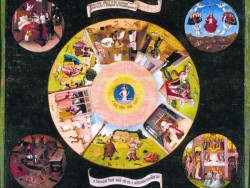
Gielis 2003
Jheronimus Bosch, de natuur van de mens en de hoofdzonden (M.A.M.E. Gielis) 2003
[in: Noordbrabants Historisch Jaarboek, 20 (2003), pp. 93-117]
Unlike Paul Vandenbroeck Gielis thinks that the Seven Deadly Sins do play an important role in the works of Bosch: Bosch has a lot of things in common with the late-medieval moralizing preachers, who were also fulminating against the Seven Deadly Sins. Nevertheless the painter has adapted the rendering of the Deadly Sins to the varying circumstances and to his own objectives. In this article Gielis focuses on the depiction of the Seven Deadly Sins in some works of Bosch, such as The Tabletop with the Seven Deadly Sins, the Garden of Delights triptych (according to Gielis a depiction of sinful concupiscence, meaning: lust is no longer ruled by reason, as was God’s original intention), the Haywain triptych and the lost triptych to which the Rotterdam Pedlar, the Ship of Fools, the Allegory of Gluttony and Lust and the Death of a Miser are said to have belonged.
Gielis’ analyses largely follow in the wake of those of others (among them Vandenbroeck, Marijnissen and Koldeweij) and present but little that is new. In fact, the only new insight is Gielis’ thesis that the subject matter of the Garden of Delights (see above) is very similar to the views of the Louvain theologist Johannes Driedo (ca. 1480-1535), as presented in his Latin treatises. Furthermore some sloppy interpretations can be found in Gielis’ text. One example: in the Rotterdam Pedlar tondo the barking dog (according to Gielis a symbol of the devil) is said to have the intention to scare the pedlar (a homo viator) in order to keep him away from the house of depravity, in other words from the ill-famed inn in the background [p. 109]. A good question here would be: if the dog indeed represents the devil, isn’t it more logical that he wants to lure people towards houses of depravity, instead of chasing people away from them?
[explicit]